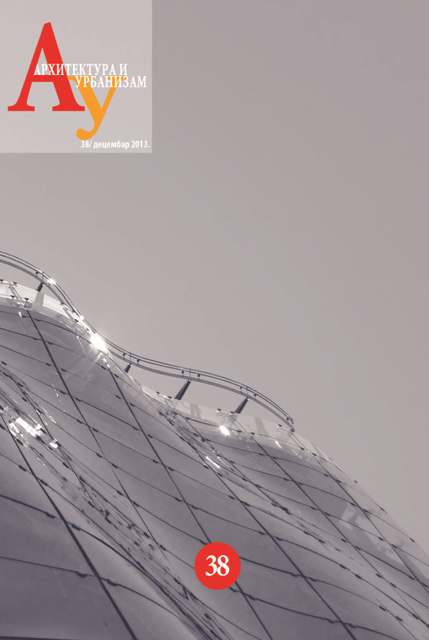Evaluation of green roof characteristics in green building assessment
Abstract
Methodology of building evaluation based on green building characteristics is rapidly gaining momentum, mainly in foreign, but also in domestic building practice. This methodology is being carried out through different Green Building Certification Systems, which are complex evaluation mechanisms based on numerous criteria of sustainability, addressing both ecological issues, but also economic and social ones. Green roof represents one of the “must have” features of contemporary buildings aiming to gain green label. This paradigm is based on their numerous characteristics which contribute to different aspects of building sustainability, among which are savings in energy and water consumption, but also ecological balance and quality of built environment. Criteria used for evaluation of green roof solutions and their overall contribution to the building, are integral part of all of the mentioned certification systems, but the way they are structured and formulated inside each system varies significantly, hence causing differences in evaluation results. This paper presents the analysis of green roof related criteria of three characteristic green building certification systems: LEED, BREEAM and CASBEE. These systems are chosen primarily because of the different evaluation methodology, but also because of their market prevalence and perspectives of usage in the domestic practice. Conclusions driven from these analyses and comparisons provide insight into main aspect of green roof planning and construction which are relevant for the overall building sustainability assessment.
References
Ansel, W., & Appl, R. 2004. Future and sustainable green roofs in Germany. In Greening Rooftops for Sustainable Communities, Proceedings of the Second North American Green Roofs Conference, Portland, June 2004. Toronto: The Cardinal Group.
BREEAM. New Construction Non-Domestic Buildings Technical Manual SD5073 - 2.0: 2011. Watford, United Kingdom: BRE Global; 2011. http://www.breeam.org/
Ding,G. (2008) Sustainable construction: The role of environmental assessment tools. Journal of Environmental Management, Volume 86, Issue 3, p. 451-464
Ebert, T., Eβig, N., Hauser, G (2011). Green building certification systems. Institut für internationale Architektur- Dokumentation GmbH & Co. KG- A specialist book from Redaktion DETAIL, Munich.
Ignjatović, D., Ćuković- Ignjatović, N., Stanković, B. (2011) Architectural design energy efficiency assessment methods for building design and renovations. Proceedings: Building Services & Architecture 2011 International Conference, October 27 - 28, 2002, Belgrade, Serbia
Jovanović- Popović, M., Kosanović, S. (2009) Selection of building materials based upon ecological characteristics: priorities in function of environmental protection. Spatium 20, p. 23-27.
Jovanović-Popović, M., Samardžić, S., Kosanović, S. i Marković, B. (2008) Unapređenje energetske efikasnosti gradova / zgrada kroz proces energetske sertifikacije. Međunarodni naučni skup: Održivi prostorni razvoj gradova. Beograd, 25 – 26. januar 2008. Tematski zbornik radova: drugi deo. Beograd: Institut za arhitekturu i urbanizam Srbije, str. 229 – 240.
JSBC. Comprehensive Assessment System for Built Environment Efficiency (CASBEE) for New Construction Assessment Manual: 2010 Edition. Tokyo, Japan: Japan Sustainable Building Consortium; 2011. http://www.ibec.or.jp/CASBEE/english/
Köhler, M., Wiartalla, W., and Feige, R. (2007). Positive interaction between PV-systems and extensive green roofs. Green Roof Infrastructure Monitor, 9, 1. Pp 14-15.
Larsson, Nils. (2000) Green Building: An Overview. http://fmv.fcm.ca/files/Capacity_Building_-_MBRG/GB_policy_may_En.pdf pristupljeno 07.09.2011
Papadopoulos, A.M. and Giama, E. (2007) Rating systems for counting buildings environmental performance. In: M. Santamouris and P. Wouters, eds. Proceedings of the 2nd PALENC conference and 28th AIVC conference –building low energy cooling and advanced ventilation technologies in the 21st century (PALENC 2007), 27–29 September, CRETE Island, Greece, p. 754–758.
Секулић, М. (2013). Развој и трансформације кровног врта од настанка до данас и његова савремена примена. Докторска дисертација, Нови Сад: ФТН – Департман за архитектуру и урбанизам
USGBC. LEED Reference Guide for Green Building Design and Construction: For the Design, Constructions and Major Renovations of Commercial and Institutional Buildings Including Core & Shell and K-12 School Projects: 2009 Edition. Washington DC: US Green Building Council; 2009. http://www.usgbc.org/leed
Hake, A.(2007) Promoting sustainable green roofs through Leadership in Energy and Environmental Design (LEED). Department of Landscape Architecture, University of Missouri-Columbia
Cole, R. (2003) Building Environmental Assessment Methods: A measure of Success. Int. Electr. J. Construct, Special Issue on the Future of Sustainable Construction.
Црнчевић, Т. и Секулић, М. (2012). Зелени кровови у контексту климатских промена - преглед нових искустава. Београд: Архитектура и урбанизам, 36
Wu, P., Low, S.P. (2010) Project Management and Green Buildings:Lessons from the Rating Systems. Journal of professional Issues in Engineering Education and Practice.
Wen, Y. C. (2005) Comparison of two sustainable building assessment tools applied to Holmen project in Stockholm. Master of Science Thesis in Built Environment Analysis. Royal Institute of Technology, Stockholm.

